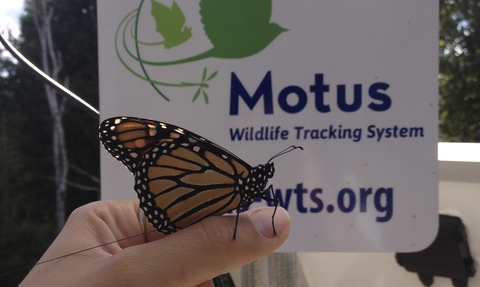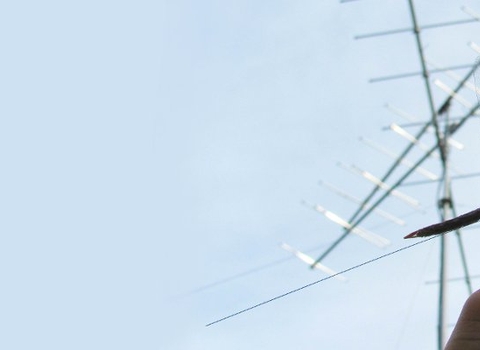What is Manx Motus?
The establishment of a Motus station at the Calf of Man Bird Observatory in spring 2022 is the start of a wider aim to develop a network of stations across the Isle of Man, which will then provide comprehensive coverage of our geographical location in the middle of the Irish Sea. Although the station on the Calf will be the first of its kind on the western seaboard of the British Isles, it is anticipated that the UK network will undergo a significant expansion during the coming decade allowing for a much greater detection of migratory animals leaving and arriving on the Island. It will also be possible to undertake more detailed studies of local species, such as Red-billed Chough, which are considered more sedentary.
Motus on the Isle of Man provides opportunities for:
Multi-disciplinary Science
- Movement, migration, and population ecology
- Animal behaviour and physiology studies
- Environmental management
Conservation
- Population, survival, and species dynamics
- Stopover, site-based, and full life-cycle knowledge
- Informing use of flyways and landscapes
Education
- Undergraduate through postgraduate studies
- Open framework for development, code, and analysis sharing
- Public engagement and storytelling
How can you help?
We are seeking assistance from individuals or companies and organisations to:
- Grant permission to install one or more telemetry stations on suitable land
- Grant access to researchers for periodic inspections, downloads, and maintenance throughout the life of the project (minimum once a year, max 3 times a year)
- Provide a point of contact to facilitate the process
- Site specific: When amenable and appropriate, allow the use of current infrastructure to affix antenna and store hardware in lieu of independent towers
- Site specific: When amenable and appropriate, supply minimal power required to run equipment
- Site specific: When amenable and appropriate, supply internet access to allow automatic data download
- When possible, fund the equipment, installation, and maintenance of Motus stations.
Funding a Motus Station:
- The cost of the equipment ranges from about £3,000 to £5,000 per station, depending on the type of setup (e.g. solar vs. power, tower vs. building, number of antenna, etc.).
- Annual maintenance costs range from £100 to £500 per station/year depending on the remoteness of the station, whether or not they are powered or have internet access.
- Landowners or interested parties can also fund a station which enables Motus and collaborators to expand and maintain the system elsewhere, and help to support the fundamental database management, web tools, program and project coordination that keep the whole system operating.
Funding for Tags
- VHF Avian tags range in costs from about £120 depending on size and type of tag (nano, solar etc)
For more information and to discuss how you might assist with this new and exciting project, please email: calfbirdwarden@mwt.im
About Motus
The Motus Wildlife Tracking System (Motus) is an international collaborative research network that uses coordinated automated radio telemetry to facilitate research and education on the ecology and conservation of migratory animals. Motus is a program led by Birds Canada in partnership with collaborating researchers and organisations.
Motus is an international collaborative network of researchers that use automated radio telemetry to simultaneously track hundreds of individuals of numerous species of birds, bats, and insects. The system enables a community of researchers, educators, organizations, and citizens to undertake impactful research and education on the ecology and conservation of migratory animals. When compared to other technologies, automated radio telemetry currently allows researchers to track the smallest animals possible, with high temporal and geographic precision, over great distances.
When tracking wildlife with automated radio telemetry over vast distances, the challenge of deploying enough receivers to get detections grows exponentially. To remedy this, data can be shared between all researchers so that essentially everyone is sharing receivers.

How does Motus work?
The philosophy behind Motus is that we’re all working together. At its core, Motus is community science. A community of researchers around the world conducting research on animals that are tracked by a network of coordinated receiving stations. These stations are maintained by a community of researchers, organizations, non-profits, governments, and individuals. For this concept to work, the system requires a centralized database and management system that all participants use.
While any automated telemetry project can operate in isolation, operating as a Motus project combines the collective impact of local, regional, and even hemispheric projects into one massive collaborative effort that expands the scale and scope of everyone’s work and maximizes the use of scarce funding.
It also makes data available and more useful for future projects, provides opportunity for collaborative endeavours and significant community engagement, through:
- Coordinated global network of automated radio telemetry receivers.
- Being part of a global research and conservation community.
- Collaborators have full control over data access.
- Projects can be designed based on the placement of third-party stations.
- Tagging data from multiple projects can be utilized in large-scale studies.
- Communication, troubleshooting, and consultation from other researchers in the community, Motus staff and technology partners.
Find out from MWT Ornithological Warden on the Calf of Man, Aron Sapsford, about the Motus station due to be installed at the Calf of Man Bird Observatory in spring 2022!


